

Himiko of Maurya / Majapahit / Qing China
Small map, Terra Incognita, 4 AI Opponents
Deity difficulty
Patch 1.2
Anyone reading these reports probably knows that Civ7 had a rocky reception at launch. Despite looking very pretty, the game received mediocre reviews from the official gaming press and savagely negative reviews from the general community, with things getting so bad that Civ7 actually had more negative than positive reviews on Steam (almost unheard of for a big budget strategy game). I extensively documented some of the major problems with the gameplay on Livestream, on YouTube, and here on my website as the release version of the game sputtered out of the gate. Still, that was only the release version of the game, and Civilization games tend to get much better with patches, right? When a major new patch (1.2) dropped at the end of April, I had to check it out to see for myself what had been improved. The developers also claimed that the AI was much improved in this patch and that players might have to lower the difficulty level to compensate; I was skeptical to say the least and instead dialed things up to the hardest Deity setting for the first time. Were things genuinely different in this patch?
Spoiler alert: no, not at all, Civ7 is still basically the same game as before. But hopefully you'll still stick around to read the rest of this report anyway. 
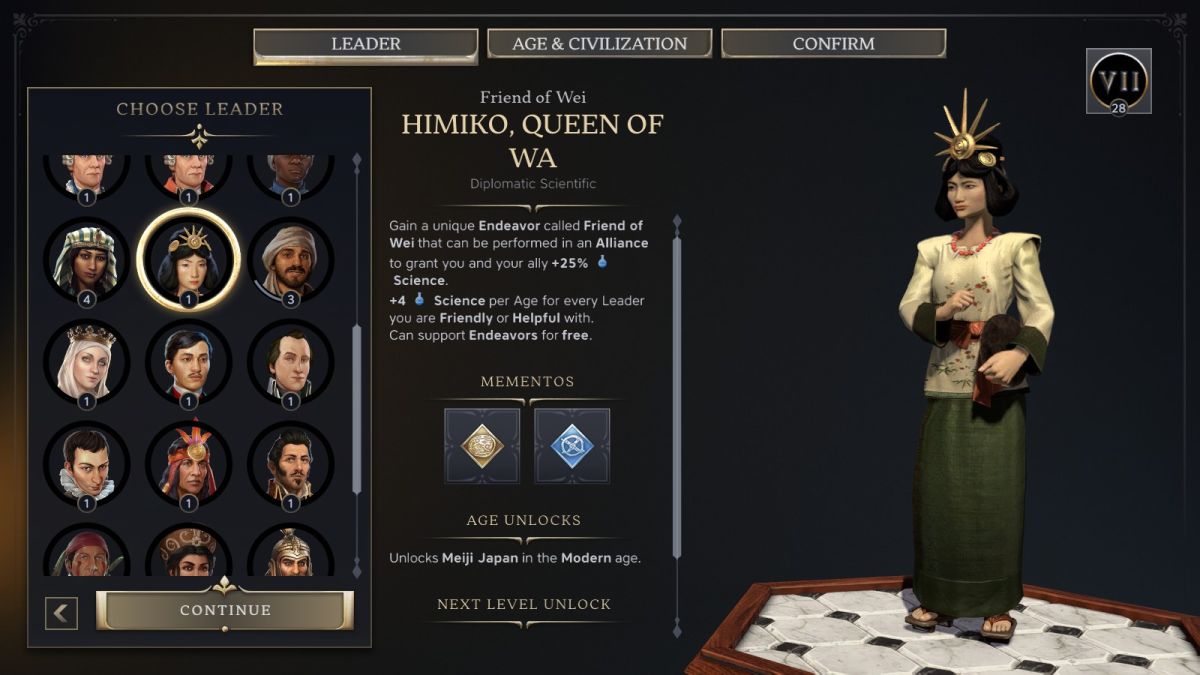
For my leader choice in this game, I wanted to test out Himiko who is widely seen as being one of the strongest leaders in Civ7. Himiko is among the most peaceful leaders in Civ7 and I recalled from my Game of the Month #2 effort that she had been the only effective AI amid a sea of dunces. Himiko's greatest ability is the one listed at the bottom of that screenshot: can support endeavors for free. This is extremely strong as it means that the player can gain the full benefit of those various AI requests without having to spend influence on them. This allows the player to get the boosted effects of those endeavors for free (such as getting 6 science from an Ancient era research endeavor), and build diplomacy with those AI leaders in the process (since the AI likes it when you support their endeavors), *AND* also save influence for befriending city states too! On top of that, Himiko then also gets 4 science per age for every Friendly or Helpful AI leader, plus another powerful special endeavor that grants 25% extra science (!) while in an alliance. Thus Himiko has a straightforward gameplay approach: support lots of endeavors, make lots of friends, run away with the game in science. I had an old Civ5 report where I wrote about the Art of Wu, this was a new Civ7 version that led me to name this game the Art of Wa.
This is also the screen where the player can assign mementos and I picked the one that grants 200 starting gold along with a Scientific attribute point. The extra starting gold is very helpful in the Ancient era for getting out to a fast start while I couldn't find anything else more useful for the other memento. There are something like 100 of those things and I've only unlocked two dozen of them thus far, nor do I care about spamming games just to unlock the stupid things. These mementos would work well enough.
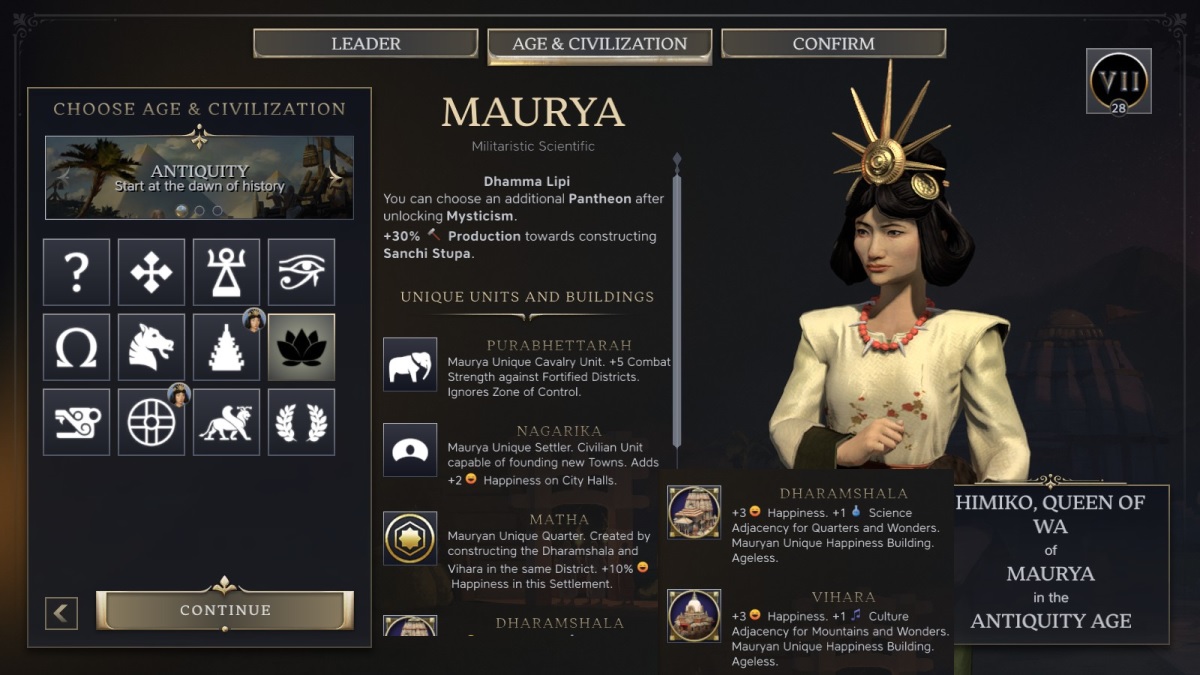
I wanted to try another new civ for this game and picked Maurya, the Indian civilization associated with Asoka in real life. The Maurya are essentially the happiness civ for the Ancient era, with a unique unit and a unique quarter that each grant bonus happiness. This civ gets a unique settler that grants 2 extra happiness on founding a settlement, two buildings in the unique quarter worth 3 happiness apiece along with minor science and culture adjacencies, then another 10% extra happiness upon completing the full quarter. That's a minimum of 8.8 extra happy faces which is almost enough to offset the -10 unhappiness from going two settlements above the cap, though of course it's not as good as the direct +1 settlement limit granted by Xerxes since the player does have to construct the buildings and pay gold for their maintenance. I've found that happiness is a major constraint in Civ7 and having more of it does lots of good things, letting you push expansion further and unlock more policies via faster celebrations. I thought it would be fun to lean heavily into the happiness angle in this game and see how it went.
Maurya's other two uniques are a second pantheon benefit on their altars and an elephant unique unit which is better than normal at attacking fortified districts. These are very much in the "nice to have" category without having many noticeable effects on the gameplay. More relevant were the map settings that I picked for this game: I was sticking with my normal Small size but changing up the map to a different script called Terra Incognito. This one supposedly creates a more random landmass for the "distant lands" continent even though the starting continent remains depressingly identical to the usual fare. It was something I hadn't tried yet so sure, why not. I also wanted to create some more room for expansion in this game and therefore removed one of the AI leaders by having 4 rivals instead of the default 5. Hopefully this would create space for everyone to stretch out and I could use that extra Maurya happiness for some more settlements.
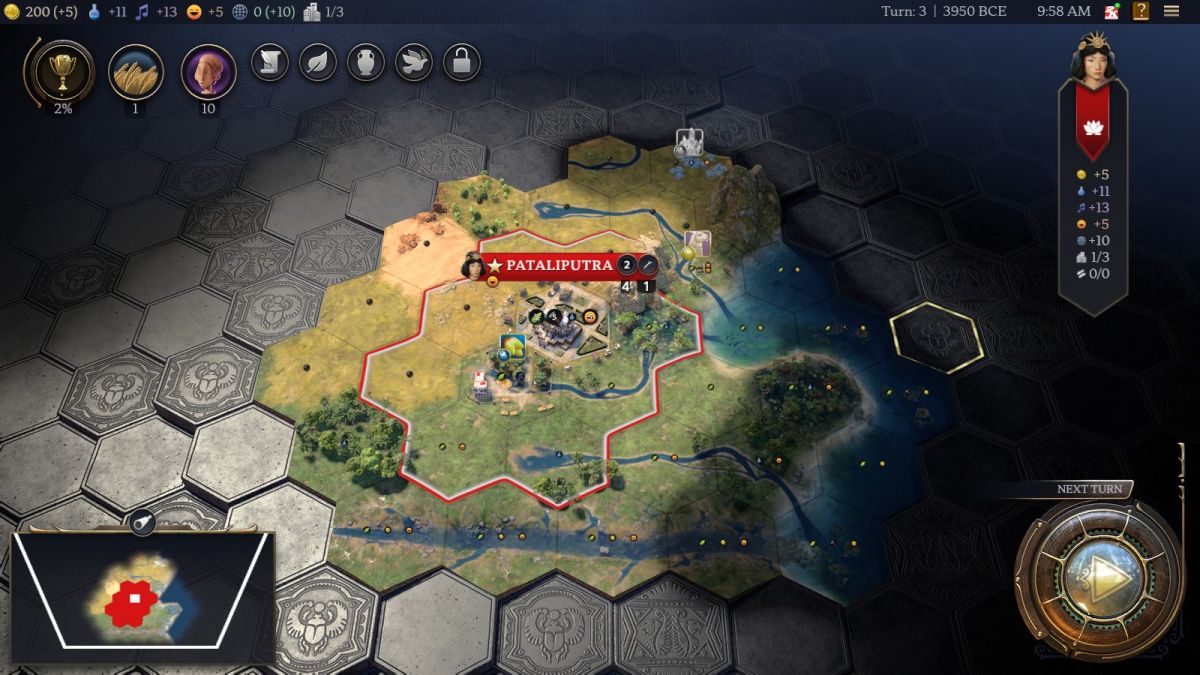
This was the start that I drew after settling the initial city. Unfortunately I had to spend two turns moving from where the settler began two tiles to the southeast, and I hated to waste that delay, but there was really no choice as the capital became much stronger by getting the gypsum resource into range. This move also brought more future mines into range which would be good for production and removed coastal tiles; it's good to have some coastal tiles available without having too many of them. Some of the new resources added by the recent patch were also visible in the form of llamas (+1 production and +3 happiness) and mangoes (+2 food and +2 culture). My plan was to start with the usual scout builds, invest my starting gold into a quick purchased granary to the northeast to reach the gypsum faster, and then pump settlers to claim land as soon as possible.
Probably the biggest change in Patch 1.2 was a reworking of the city growth formula in Civ7. I wrote a whole post about this at CivFanatics for anyone who wants to dig deeply into the numbers, however the short version is that cities grow slower for the first few pop increases, then hit the break even point and start to grow faster thereafter, MUCH faster in the Ancient era in particular where the old math was simply absurd. This is a positive change overall and it helps to make food more valuable (though production is still far more important), however cities do grow noticeably slower for the first few pop increases. Since settlers can't be trained until reaching size 5 in Civ7, this makes a cash-rushed building more important than ever because each building adds to the city size and cuts off a food threshhold needed to go into settler production. For this reason, I currently view the memento that starts the player with 200 gold as almost mandatory to pick since otherwise it takes way too long to hit size 5. You have to get lucky popping gold from goody huts and that's not a consistent strategy.
Anyway, I founded my capital on Turn 3, got the initial freebie scout finished on Turn 4, and then ran into this on Turn 6:
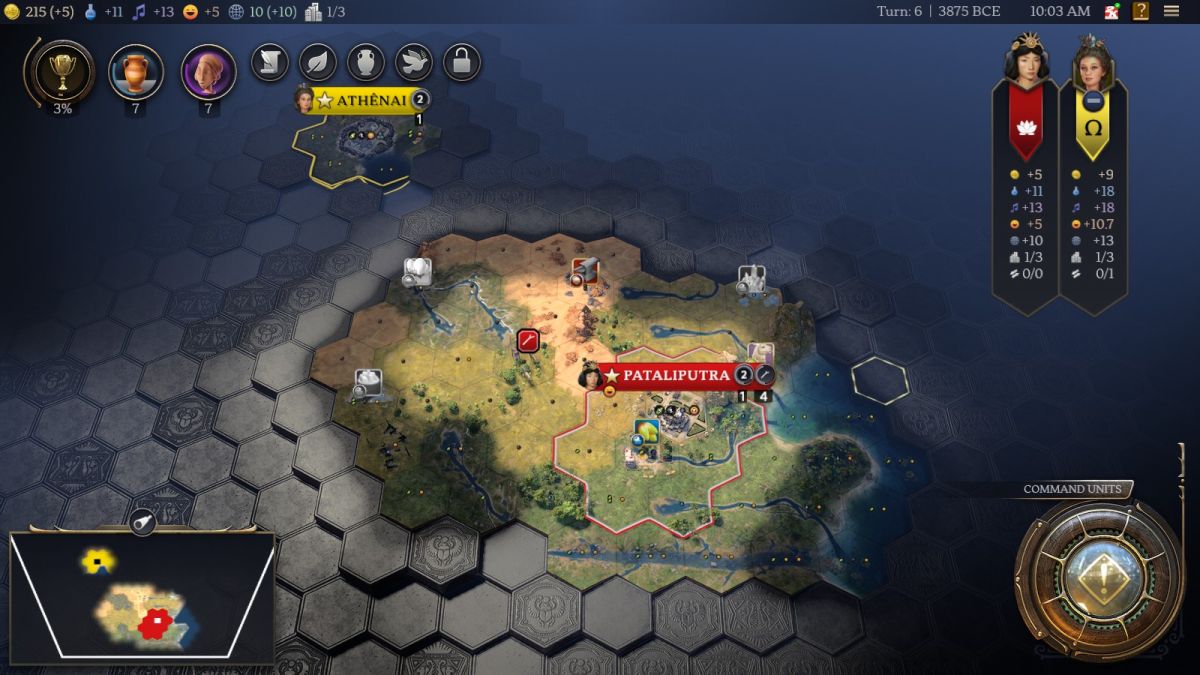
Catherine was a mere 10 tiles away, argh! This was not what I wanted as I knew immediately that the odds of staying peaceful with her would be almost nil. I was going to have to race with the Russian leader to claim this disputed territory between us and with her having the various Deity bonuses to tilt the odds in her favor. At least it turned out that there was a minor lake to the south of Athenai which helped to keep Cathy's Greek units out of my hair for the time being. At the moment, all that I could do was purchase the granary for 220 gold on the following turn, then grab the mango resource for a nifty 5 food / 3 culture yield after assigning the resource to Patilaputra. And speaking of culture:
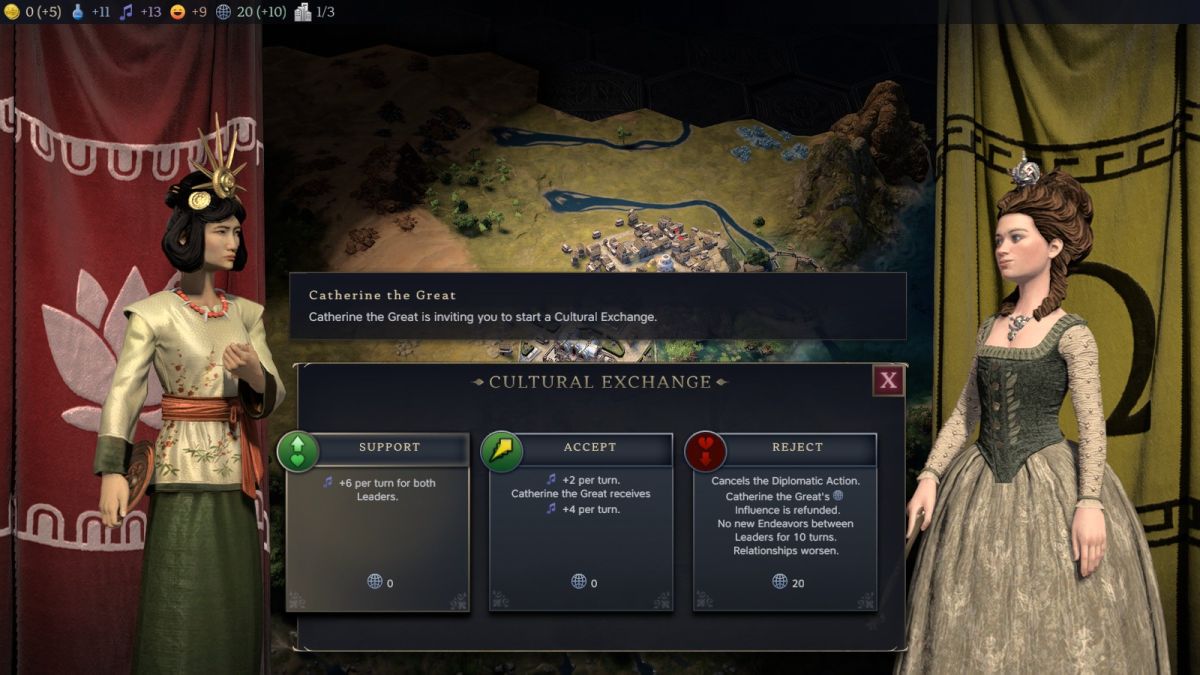
Catherine immediately dialed me up to ask for a cultural exchange on Turn 7. I would not have been able to pay the 60 influence to support the measure, having already used 20 influence on the "friendly" greeting upon first contact, except of course that I could do so for free since I was playing as Himiko. This gained me 6 culture/turn and then a few turns later Cathy came back and asked for a research endeavor, which I was also able to support free of charge for another 6 beakers/turn! Players start out making 10 science and 10 culture each turn in Civ7, and here I was sitting at 18 beakers and 19 culture per turn as early as Turn 10, not bad at all. Of course Cathy was also getting the same benefit and she was up around 30 of each yield already but I wasn't worried about that. The AI stinks at city building in Civ7 and I knew Cathy would waste any advantage she gained from these early endeavors, while speeding my own path through the tech and civic trees would prove far more useful. This was a great example of how strong Himiko can be in the right circumstances.
As if meeting Cathy so quickly wasn't enough, I ran into a scout from Harriet Tubman of Egypt on Turn 12. Then I met Benjamin Franklin of Rome the next turn, and oh come on!  Look at this:
Look at this:

Franklin's capital of Roma was a mere 11 tiles away from where I had my city, and that was only because I had moved slightly northwest or he would have been even closer. The terrain between us was very rough indeed, with a wide river valley followed by jagged mountains and then a lake near Roma itself, but this was still ridiculous. There were only five total nations in this game and three of them were crammed together on the eastern seaboard, with Tubman not that much further to the west of Catherine. Wait a minute, you might think, didn't you remove one of the AI leaders before starting this game? Shouldn't that create more room for everyone? As it turns out, removing AI leaders in Civ7 will *ALWAYS* remove them from the "distant lands" first. You can be playing on a Standard size map which normally has 7 AI opponents, and if you take out 3 AI leaders, the remaining 4 AIs will always remain on the starting continent. Always, with no variation. Furthermore, Patch 1.2 apparently added a new map option called "balanced" which is off by default, and if the player does not turn on the balanced option, then the map scripting puts a bunch of AI rivals right on top of them, every time, without fail.
This... just sucks, I don't know how else to describe it. It's yet another example of how Civ7 feels like an on-rails experience, with the player forced into the same situations over and over again. The developers apparently decided that the player would always be cramped on territory right from the start and the maps are contrived to produce this result every time. You can never have open space, you can never have breathing room, not unless the player does something wacky like removing all but one or two opponents. I don't mind fighting my way out of a sardine can every now and then in the Civ games, it can even be a fun challenge, but it's not cool to do this in every single game without fail. I'd really just like the chance to play a builder game sometimes which unfortunately the developers have decided isn't possible.

In any case, I used the influence that had been building up for the last few turns to send friendly greetings to Tubman and Franklin, in the hopes that maybe by some miracle I could continue my pregame hopes of playing a peaceful game. These leaders evidently had spare influence of their own to burn because Franklin dialed me up for a local festival followed by a research endeavor on back to back turns, which I was very happy to support for free in both cases. Normally the player can only have one endeavor of each type running at any point in time, however Franklin's leader ability lets him uniquely have two of the same endeavor in operation simultaneously and that apparently let me support double research agreements. I was getting 12 beakers/turn absolutely for free out of that pair, thanks Cathy and Ben! Elsewhere, I used these turns to defog the map with three scouts and claim as many goody huts as possible. You don't get nearly as many of them on Deity where the AI has more units wandering around but I did take a 75 gold reward and a 50 gold reward - it's almost always best to take the gold options early on as they can be used for rush purchases to speed up the growth curve.
That latter 50 gold event reward took place on Turn 21 which boosted my civ to 245 gold and unlocked the pictured rush-purchase of a Brickyard. I had already claimed the three key resources at Pataliputra and therefore there was more flexibility about where to place this building. While I could have gone northwest towards the iron resource, that's an empire-wide resource that couldn't be assigned to Pataliputra itself and would only add extra strength to melee units. It would be helpful down the road without doing anything to speed up the growth curve. Since there was no immediate direction where I needed to push the city borders, I opted to combine the brickyard together with the earlier granary to complete a quarter. This picked up a beaker and a point of culture from adjacency bonuses and also ensured that the quarter was completely ageless, thus always benefiting from anything that would provide a per-quarter benefit later on. I'm highlighting this because Civ7 legitimately does city building well, creating real choices about where to grow onto rural tiles and where to place the initial buildings, certainly doing the "expand one tile at a time" mechanic vastly better than Civ5 and Civ6. I wish so badly that the rest of the gameplay had received the same amount of careful detail and attention, sigh.
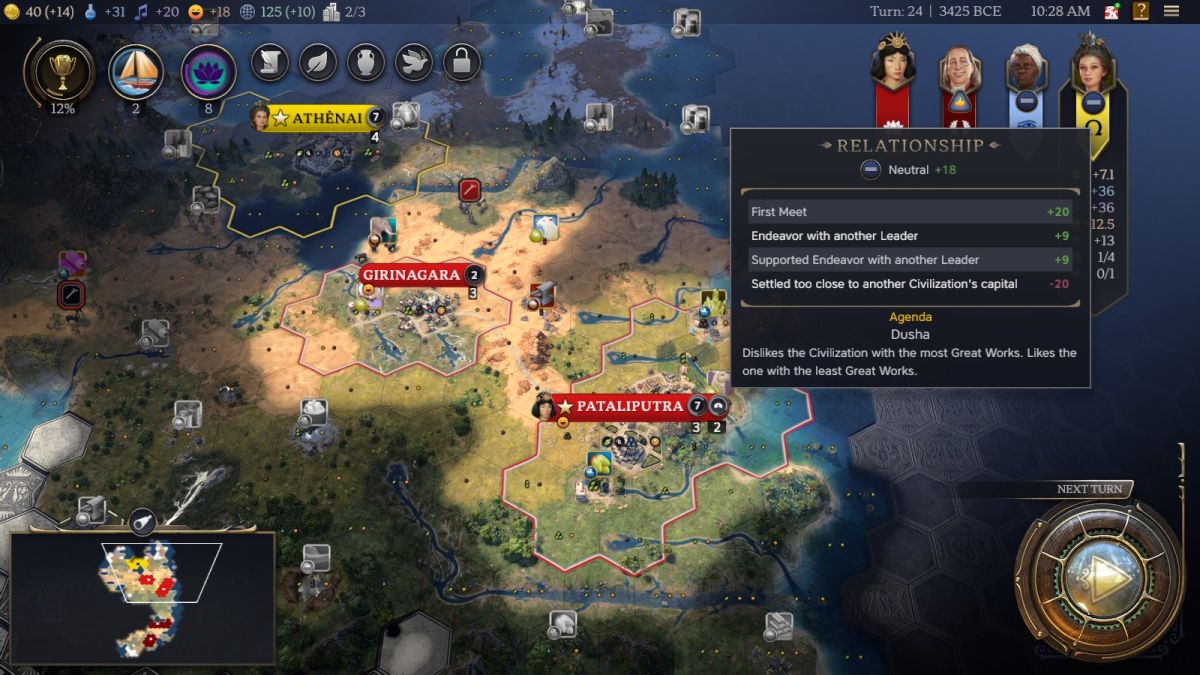
I had earlier finished one of those unique unit Maurya settlers and established the new town of Girinagara on Turn 24. I was pleased to reach this area before Catherine, as it had strong city building potential along with an initial cotton resource (+2 food and +2 production) to get it off to a fast start. I also wanted to highlight the new diplomatic summary which was added in this patch; this information was present in the release version but required digging into a submenu to see it (clicking on the leader's portrait, then clicking again to open another screen). Patch 1.2 has made the diplomatic summary much easier to see by making it a simple mouseover of the symbol under each leader's portait without requiring opening another screen. Unfortunately there's still no Diplomatic Advisor or leader matrix so you can't see how any AI leaders feel about any of the other AI leaders without going into individual submenus but this is still a nice addition.
I could spot here that my initial friendly greeting was worth 20 diplomatic points and then supporting two endeavors from Catherine was worth another 18 points which had been slowly climbing over time. However, that was offset by losing 20 points for "settling too close to another civ's capital" which there was nothing I could about. I had to expand and there was no realistic place to go other than straight towards Cathy. This diplomatic malus is the main reason why it's so hard to make friends with your neighbors in Civ7: the map generation forces the AI leaders right on top of the player, then penalizes the player for building new cities near them. I'm generally OK with this particular diplomatic penalty in theory, since there should be friction between nearby empires as they compete for land and resources.
What I'm not OK with is the current implementation of this mechanic:

Because I was slapped with the same diplomatic penalty with Benjamin Franklin when I settled my next town of Sopara. Yes, this pictured town was "too close" to Roma and was treated the same way by Civ7 as my earlier planting of Girinagara vis a vis Cathy. Obviously this didn't make even the slightest amount of logical sense, with Sopara located across a lake, over a mountain range, and on the other side of a dense jungle from Roma. However, the mechianic is apparently coded to trigger for any settlement located "within 10 tiles" of an AI capital, and sure enough, Sopara was exactly 10 tiles away from Roma. It's a great example of how something that sounds good in theory can lead to ridiculous and absurd outcomes in practice. Here's a screenshot I put together showing which parts of the map were "out of bounds" with each leader; I couldn't settle north of the white line with Cathy or south of the yellow line with Franklin. If I had been following these guidelines to play nice with my neighbors, I would be left with... zero valid settlements, awesome. Sopara was even in the sweet zone to annoy both of these leaders at once, not that there was any indication of this in-game until after it had been planted.
I really can't stress enough how badly the gameplay stacks things against the player in terms of playing a peaceful game of Civ7. The map scripting always forces the player into a tiny box, it always sets up a situation where any settlements are interpreted by the AI as "too close", and at least half of the leaders in the game have agendas that are practically guaranteed to poison relations. Franklin dislikes leaders who don't share his government, a government that I had picked on the second turn of the game before I had even met him, while someone like Xerxes will hate the player if they aren't already fighting a war against someone else. It's really, really hard to be friendly with anyone nearby; almost every AI friendship that I can recall making in Civ7 was with someone who didn't start near my capital. I'd like more tools here to offset these negative factors, it's too bad there's nothing like shared religion or favorite civics from Civ4 to butter up the AI leaders.
Cathy in particular really didn't like my continued expansion. Even though we were getting +24 diplo points from endeavors by now, I had -60 points from settling too close and another -10 points from our borders touching. I could see the writing on the wall and started training some slingers while researching the civic that unlocks the initial free army commander. It turned out that I had even less time than I expected as she declared war on Turn 40:
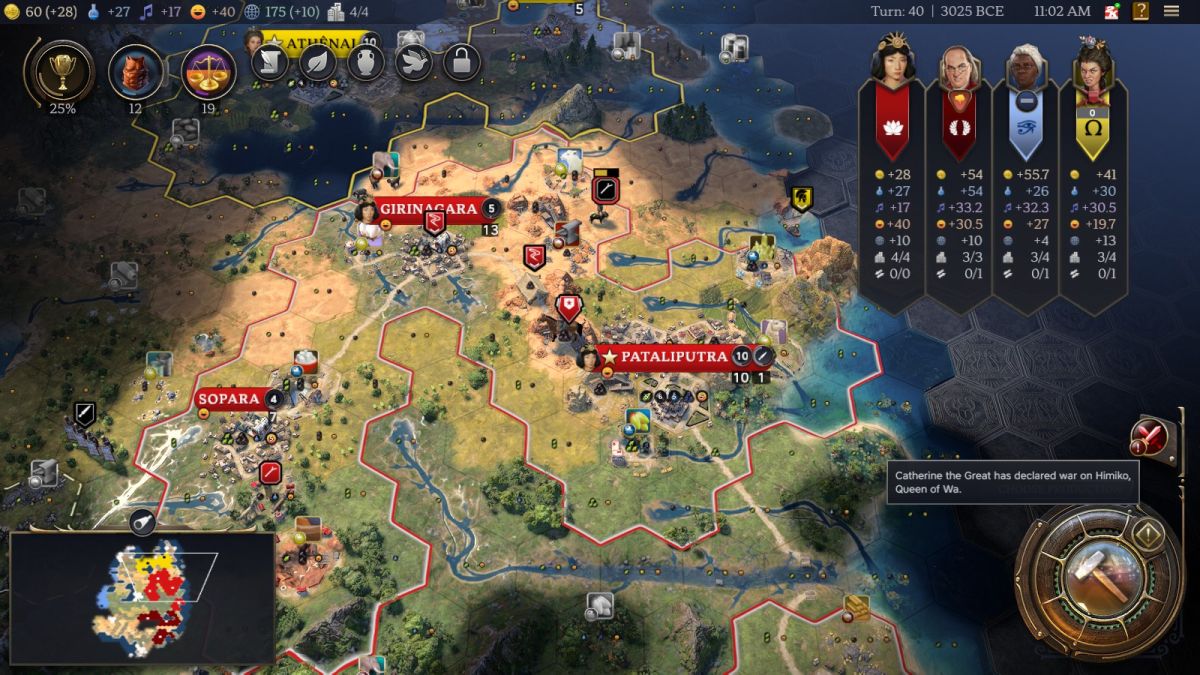
I had a grand total of two slingers and zero melee units present to meet this threat, though I was almost done with a warrior at the capital. I had also recently spent 450 gold to upgrade Girinagara into a city to unlock a second build queue; it was very much a fledgling city and I was hoping that it could stay on basic infrastructure for the moment. The good news was that Cathy wasn't particularly ready for this war either, as she attacked with a single hoplite rather than anything more dangerous. I expected the attack to arrive at Girinagara since that was my exposed border city; instead, in a fit of true AI logic, Cathy sailed this melee unit across the coast to attack my capital from the northeast. Here's why military combat can be really dangerous on Deity difficulty:
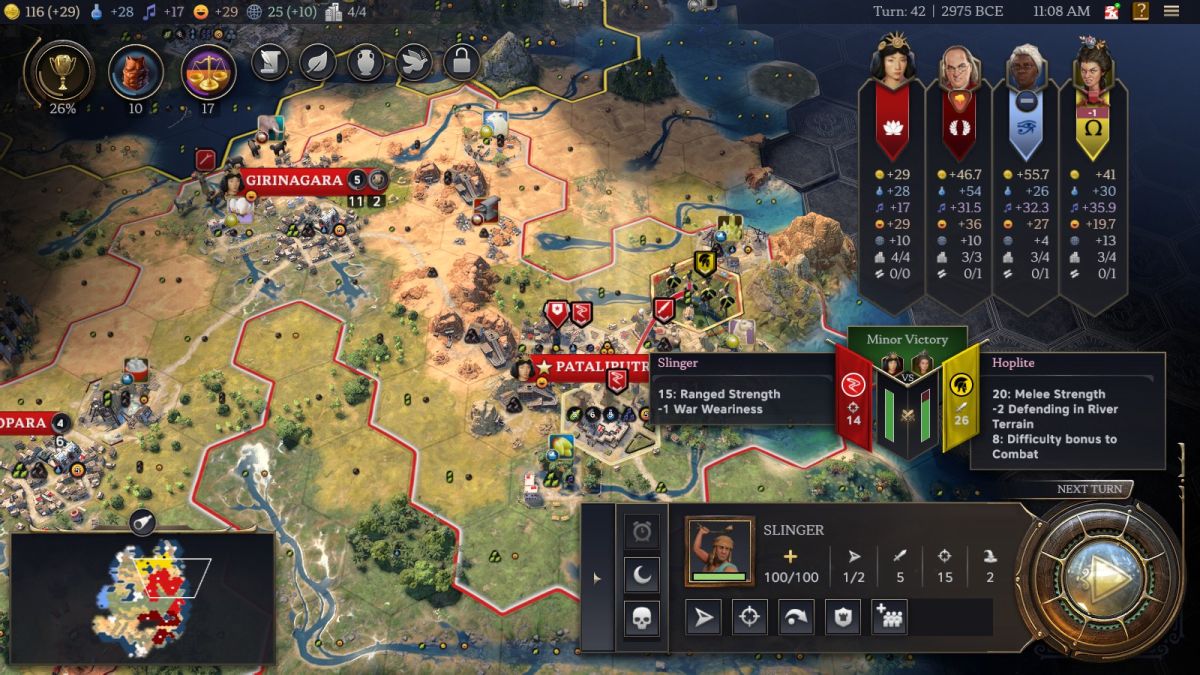
The AI units get an incredible +8 combat strength in every fight, as if they had a highly promoted army commander supporting them at all points in time. This is brutal because Civ7 uses the same combat mechanic as Civ6, where damage dealt and damage taken are based on the difference in strength between the two units. At even strength, both units will on average deal 30 damage and take 30 damage (with up to 20% variation in either direction for 24-36 damage on each side). The math of the combat starts swinging quickly as the strength differential grows, however. With an advantage of +8 strength, AI units that should be fighting at equal power will instead deal 41 damage and take 21 damage on average, clearly a massive advantage. With their production cheats they can also swarm out enormous hordes of units which are all getting that bonus, and even their terrible tactical movement only matters so much. Players basically need an army commander with the +5 combat strength commendation to fight at anything near parity on Deity difficulty, and racing to that commendation ASAP is standard practice by now amongst experienced players.
As I said though, Cathy only attacked with this one unit at first and was dumb enough to walk across a river right into the firing range of my slingers. They were firing at -12 strength differential which equated to about 19 damage per hit; two slinger attacks, one warrior defense of a hoplite attack, and two more slinger attacks on the following turn finished off this idiot. I worried greatly about a flood of more hoplites coming into my territory which would have necessitated building fortifications at Girinagara and defending behind them, only to have nothing of the sort take place. I saw another Greek slinger that I chased away and there was a hoplite visible inside Cathy's borders which never crossed into my territory, that was it. What was Cathy doing? I was content to defend for now and try to get out of the conflict as soon as she would sign peace.
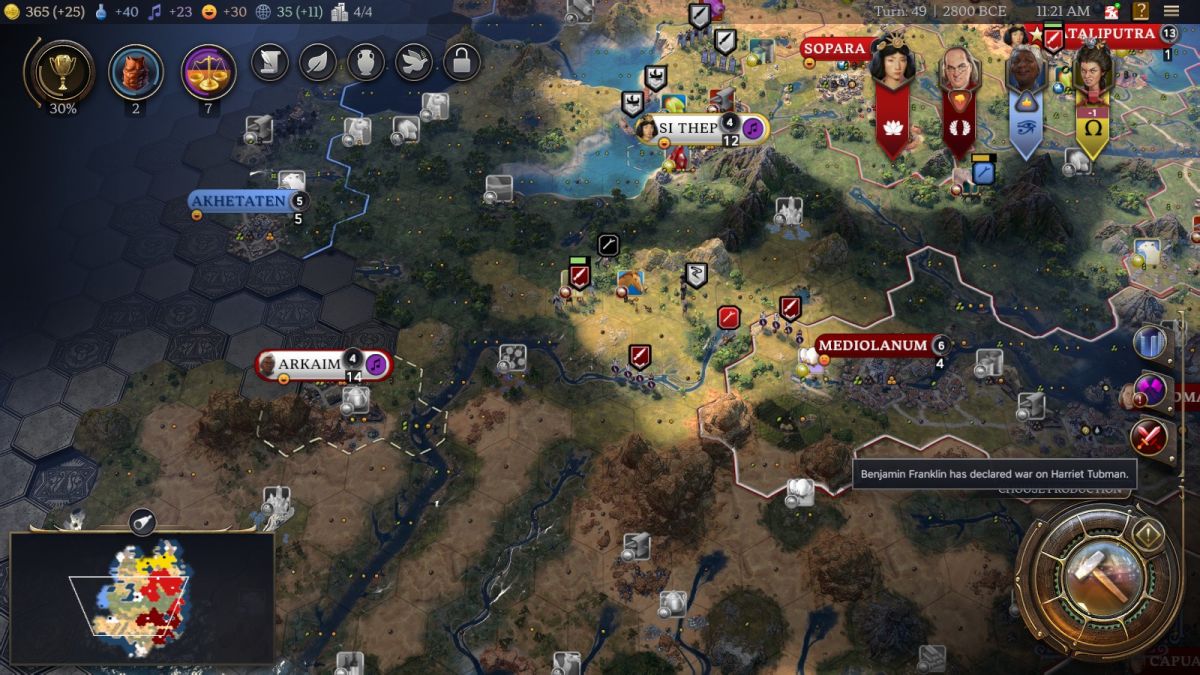
Another annoying aspect of warfare is that the AI is obsessed with spending influence on war support. Catherine had already boosted her own war which was causing an unhappiness drag on my cities as well as increasing the combat strength differential by another point to an effective +9 in her favor. I didn't have much influence at the moment because I was trying to befriend some of the independent powers, having recently filled up the meter with Cultural Si Thep to full alliance status. Si Thep granted me +2 culture on monuments for every city state alliance and there were several other independent powers out there where I thought I had a chance to land the bonus. I also caught a huge break on the pictured Turn 49 when Franklin declared war on Tubman, possibly because they had been competing over the same independent powers in this part of the map. My relations had been dropping with Franklin thanks to settling another town on his borders and this was a major relief that I wouldn't get caught in a two front war. It was a pretty bad decision by Franklin to invade Tubman since her leader ability is to gain 5 war support any time someone else attacks her, easily one of the most powerful abilities in the whole game. Franklin would accomplish very little over the rest of the Ancient age.
One other note worth mentioning: remember all those endeavors initiated by the AI leaders that I was able to support for free by virtue of being Himiko? After these wars broke out around Turn 50 of the Ancient era, I never received a single endeavor from another AI leader for the whole game. Not a single one! There were no more endeavors to support across the rest of the Ancient era, or the whole Exploration era, or the Modern era. I've never seen that happen before and I can only guess the AI leaders were pouring their influence into war support and befriending independent powers. So much for my strongest ability while playing as Himiko...
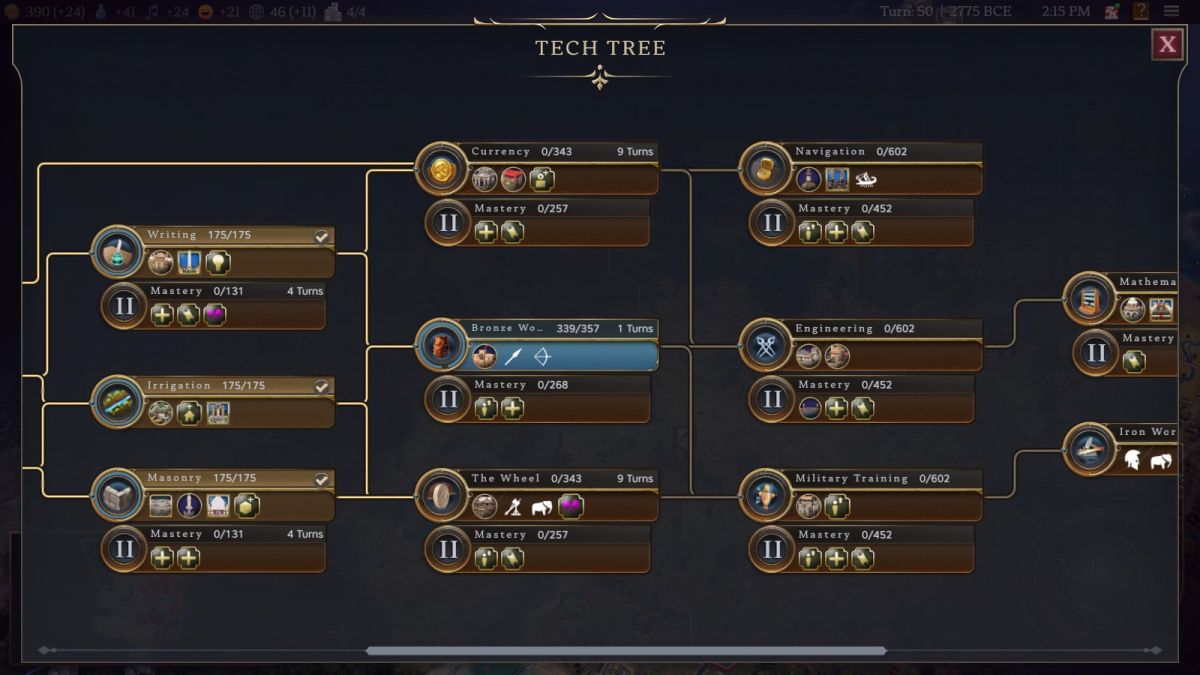
With those early cultural and research endeavors coming to a close, and new ones not taking their place, my pace through the tech and civics trees stalled out for quite a while. I had absolutely flown through the early stages of the tech tree thanks to getting 12 additional beakers for free, only to be left on my own now that the early gravy train had ended. I did prioritize Writing at an early date and my cities were working on libraries but there was only so much that could be done here until I could turn more towns into cities. The main reason why I included this screenshot though was to show the actual costs of the techs, something that had been missing before. No, they weren't added in Patch 1.2, however I did find a simple interface mod that actually tells the player how much these things cost. A lot of my screenshots are deceptive because I'm running about half a dozen different interface mods right now which I view as the bare minimum to make the game functional. The patches are slowly improving the godawful interface issues from the release version but it's still very rough in the unmodded gameplay right now.
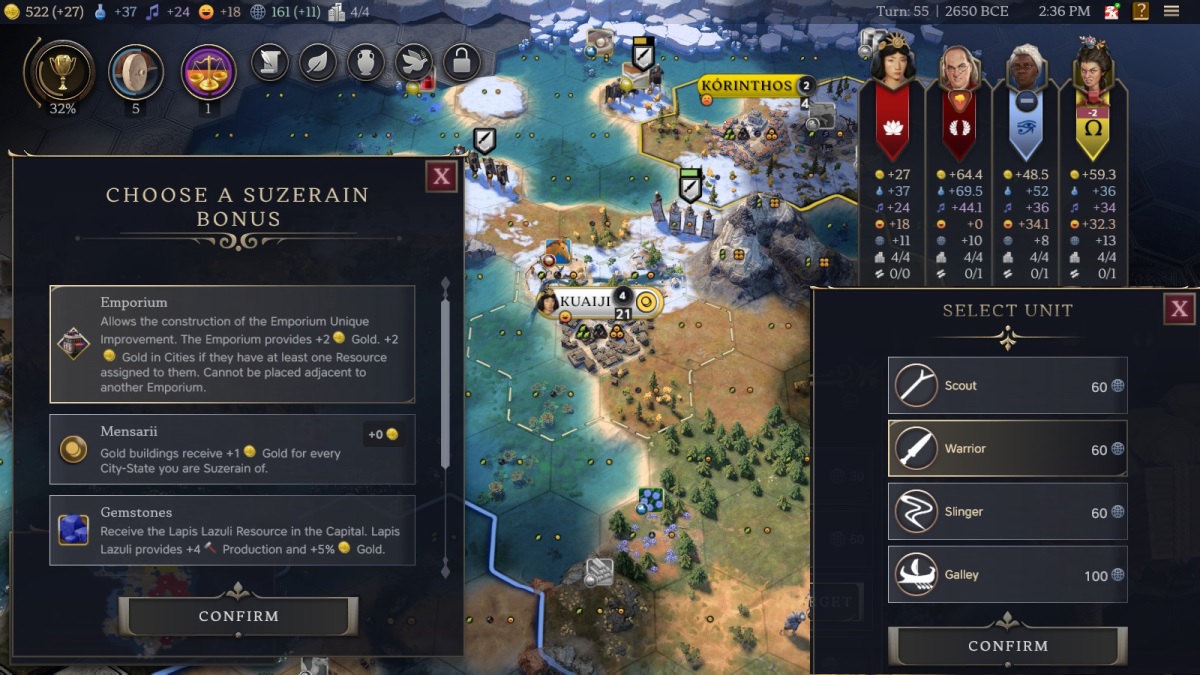
I filled up the friendship meter with another independent power on Turn 55 and was able to pick a second suzerain bonus. This was a Commercial type and I found myself choosing the Emporium option, something that I used extensively in my Augustus single city game as well. These things are really fun to add as a unique tile improvement since they're worth 4 gold in any city with a resource assigned and the only restriction is that they can't be placed next to another Emporium. It's very nice to take a mine tile that's pulling in 3 or 4 production and upgrade that to add 4 gold as well. The other unique tile improvements from city states have much more restrictive rules about where they can be added, plus the Cultural and Scentific suzerain options have lots of good stuff to choose between while the other Commercial suzerain picks are generally weak. Long story short, I keep finding myself building Emporiums and the similar Trading Posts in the Exploration age.
As far as the war with Catherine, she had made absolutely no progress against any of my settlements. However, she also refused to sign a peace treaty even after the ten turn forced duration had come to a close, plus Cathy was being a true nuisance by spending more influence on war support. I was doing OK on happiness for the moment but wanted to keep expanding further and the -2 war support was a drag on happiness that I did not need. I had to get out of this stupid conflict in some fashion... and that's when I realized that the independent power of Kuaiji that I had just befriended was sitting right next to Cathy's newest settlement. Korinthos appeared to be completely undefended and Kuaiji had multiple warriors nearby. As the suzerain I could spend influence to levy units, and while this is typically the dumbest way to spend influence in Civ7 (since influence is rare while units are cheap to build), in this one specific circumstance it looked like a strong move. I paid 120 influence to take control of two warriors, then walked them up to Korinthos and seized control of the new town:
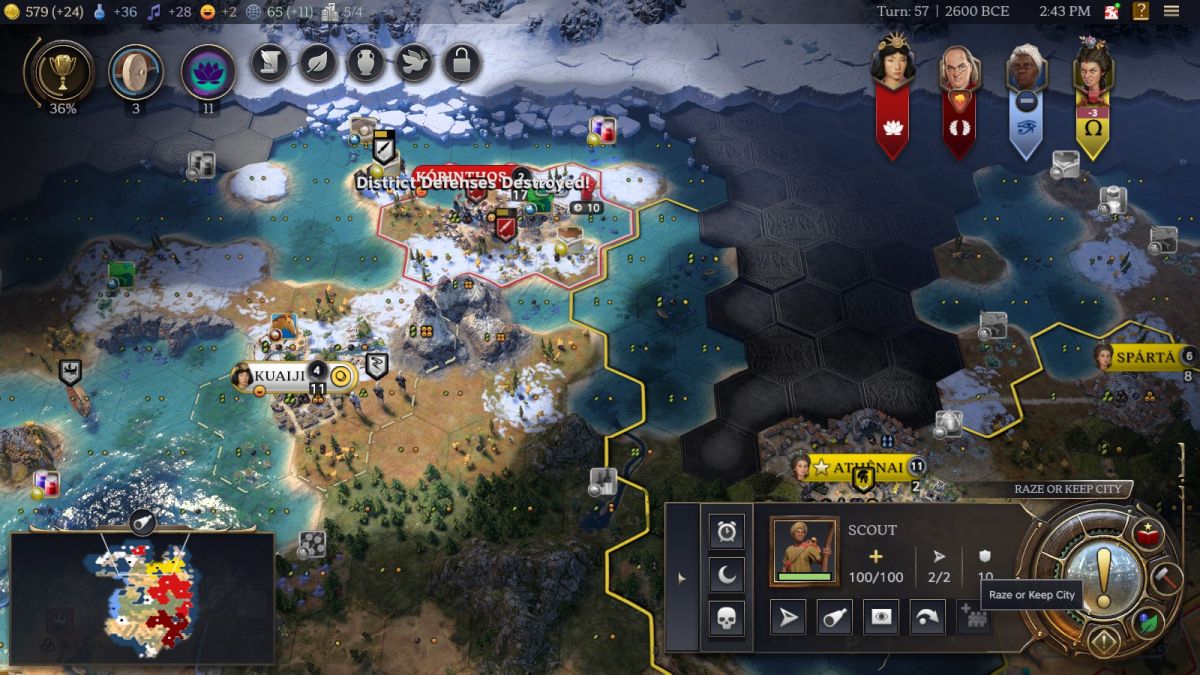
It went down in a pair of two attacks, no need for a siege or anything like that. Catherine had just planted this settlement a couple of turns earlier and she forgot to bring any units to defend it, whoops. I checked to see if I could get another city from Cathy in a peace treaty, which she was at least smart enough not to hand over, then signed an end to the fighting with Korinthos under my control. While I doubt that I would have placed a settlement there and it did count against the limit, I wasn't about to complain. I had escaped a conflict that I never wanted to fight, and with the establishment of another intended town three turns later, I was up to half a dozen settlements in all. Here was the new situation in the wake of the Greek war:
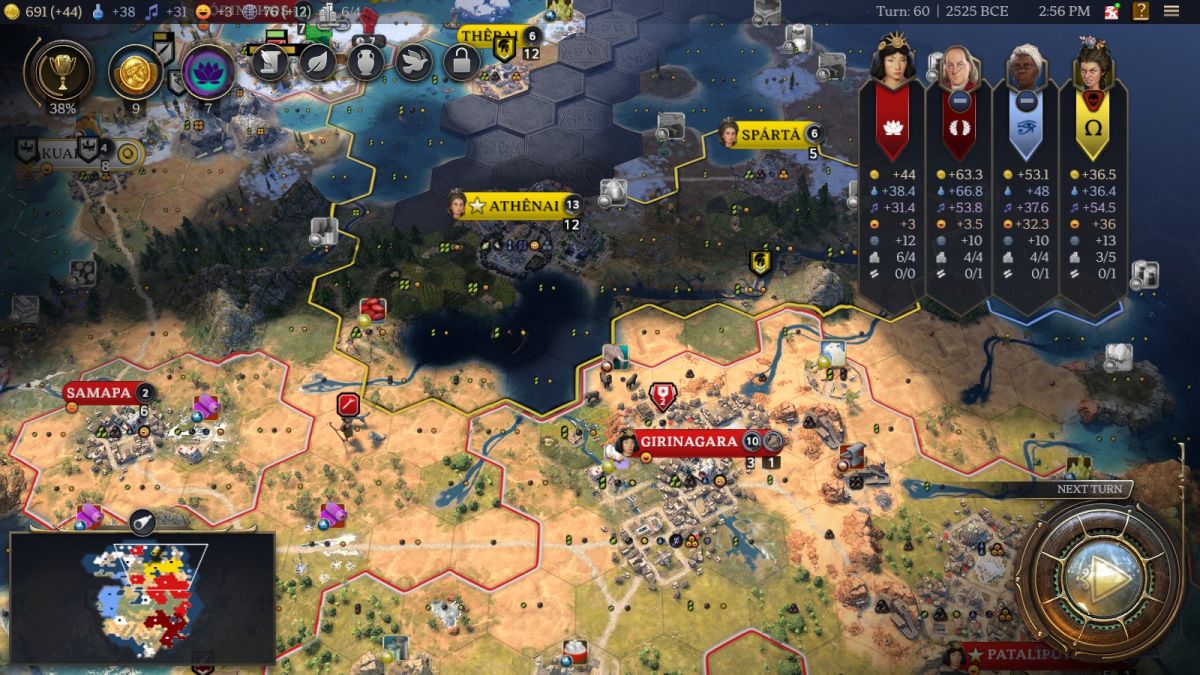
Samapa secured a connection to the northwest and linked the rest of my civ together with Korinthos, which had been outside my trade network previously. (Connections between settlements and what's inside / outside your trade network are very poorly defined in Civ7; they would benefit from some developer attention in patching.) I was kind of stunned that I'd been able to claim this much land given that I was playing on Deity difficulty. I mean, that was Cathy's capital right there! Somehow she let me settle the entirety of this region while she was off mucking around in the tundra. This may have been a case of where the AI's start bias ended up cripping their own game; since Catherine gets various bonuses from tundra cities, she apparently went out of her way to do nothing but expand into the tundra which was surely a mistake. With two cities and a third town to her name, Cathy was pretty clearly finished as a major power in this game. She was still competitive with me on science and culture and gold income for the moment, however that was about to change as I could finally start developing my non-capital settlements with this war in the rear view mirror.
I remained behind the other two AI leaders although nothing like the situation that I would have faced in a game like Civ4 or Master of Orion. Franklin and Tubman were slightly ahead though not to any worrying degree, and I was actually outexpanding them even without counting the town that I had sniped from Cathy. The biggest thing that was holding me back at the moment was unhappiness thanks to being two settlements above the cap, with this fortunately being a very solvable problem due to having picked the Maurya for my civ. We were about to see how useful their various happiness-related bonuses would be. (For the curious, the penalty for unhappiness in Civ7 is -2% to all yields for each unhappy face in a settlement, capping out at -100% to everything at -50 unhappiness though any such settlement will likely have revolted away to another civ by that point. No, the game never explains any of this to the player.)
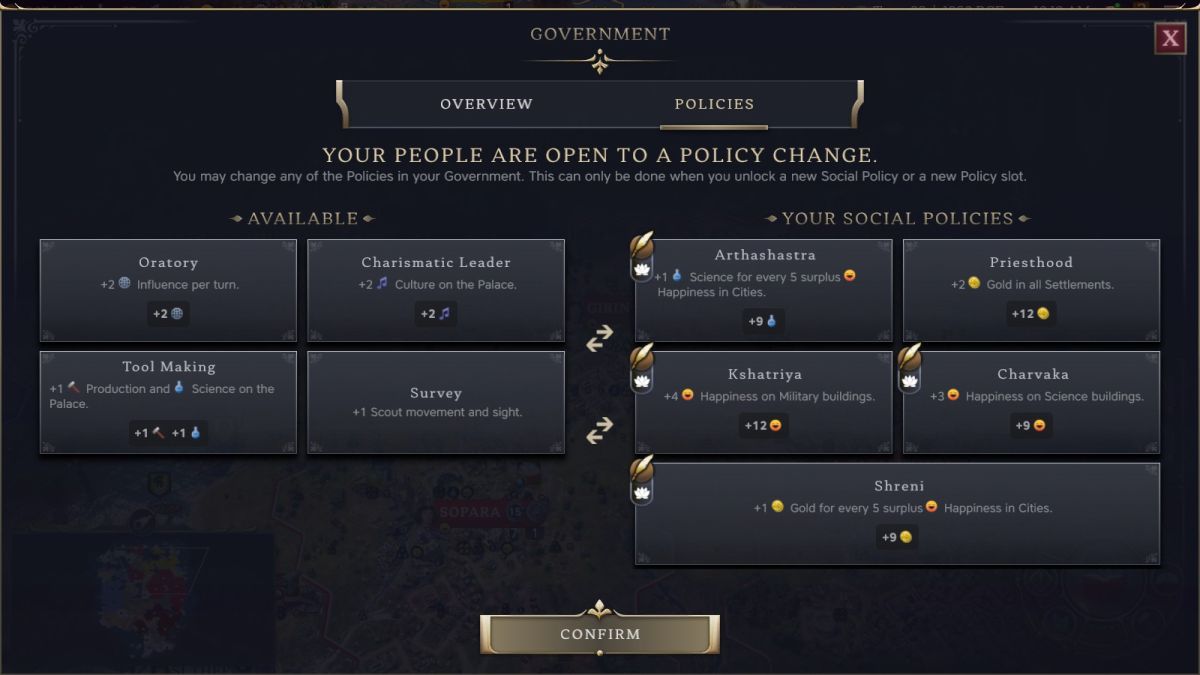
With Cathy subdued and Franklin/Tubman still ramming Ancient era units into one another, I was finally able to do what I had wanted from the beginning and settle down to play a builder's game. I started by spending 700 gold to upgrade Sopara into a city which would give me a trio of strong production queues right in the heart of my empire. The AI doesn't seem to prioritize upgrading towns into cities enough in Civ7 which is part of why they fall apart so badly as the gameplay gets into its later stages. I used this peaceful interlude to explore some more of the map where I was able to find more independent powers in the deep south beyond Franklin's territory. It seemed more useful to spend influence on befriending them instead of anything else; I had looked into using one of the espionage options with Catherine but they didn't seem worth it. The most recent patch nerfed them pretty hard by increasing their influence cost, lengthening the duration of how long the missions take, and increasing the influence penalty when caught. They can still be a strong option while not being the total no-brainer that they were previously.
Mostly though, I was simply building away in my cities and trying to get the Maurya unique quarter set up wherever possible for its huge happiness boost. I had emphasized researching the unique Maurya civics tree since there were a number of useful policies there; these are known as "traditions" in Civ7 and have their own icon on the policy screen. I've found that most of the default policies available to everyone are pretty weak in this game, with Priesthood being a solid choice among lots of other dud options. I was so unimpressed with the normal policies that I was running all four of the Maurya traditions here, two of which grant additional happiness on buildings and then another two which translate excess happiness into gold and science. The best part about these unique policies was that they would stick around for future eras and had the potential to continue scaling upwards with more settlements and more happiness overhead. (The projected yields from all those policies? Also an interface mod, not in the actual gameplay.)
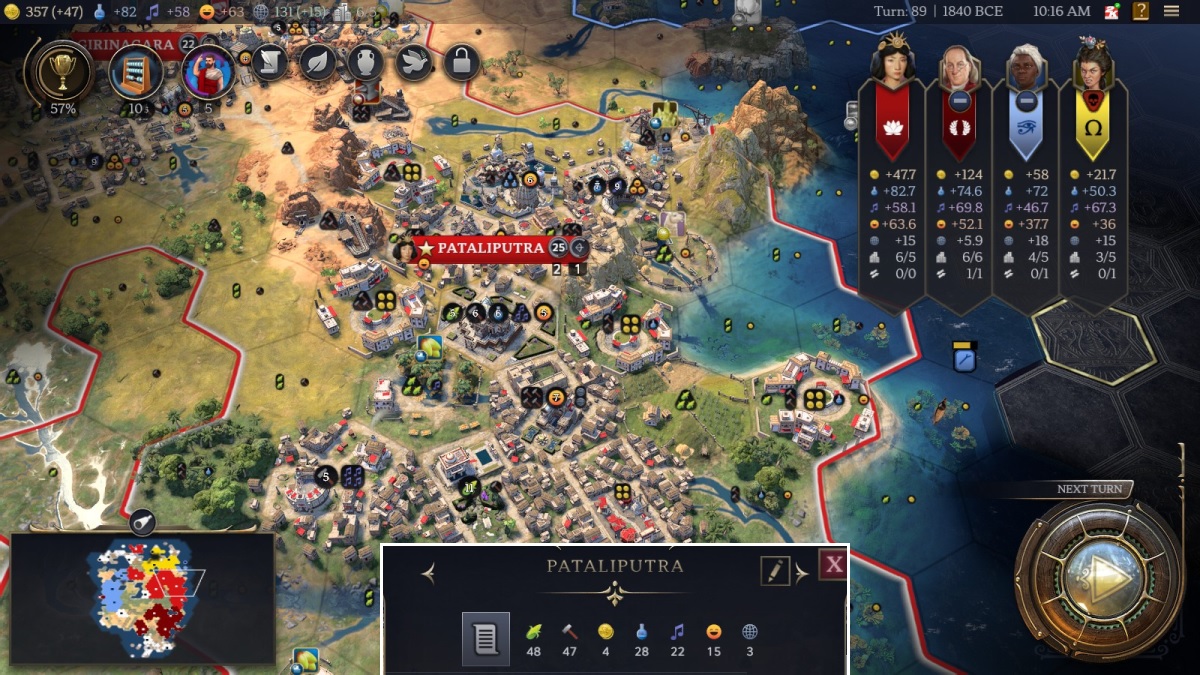
These were quiet turns as I built and built, then built some more. I took this picture of my capital after some 30 turns of peaceful interlude, with Pataliputra having constructed nearly all of the various buildings available in the Ancient era. I was quite happy with some of the building adjacencies that I was able to set up, such as the monument / library pairing two tiles northeast of the city center and the unique Mauryan quarter two tiles north of the center. There were also no fewer than four Emporiums scattered around the capital, each of them producing 4 gold/turn yields atop mines or clay pits, each of them outperforming the market built two tiles southeast of the city core. This is the most fun aspect of the gameplay for me and the biggest thing pulling me back when I get frustrated. Again, I genuinely like the city building in Civ7 and I wish that it could simply continue into future eras without anything going obsolete or having to be overbuilt.
In terms of the civ-wide comparisons, these 30 turns of peace had brought me into rough parity with Franklin and Tubman. Whereas before I had been a bit behind, now I was the clear leader in science and only barely trailing in culture. The only real advantage that any AI leader had was Franklin's big 124 gold/turn income due to him having additional towns in comparison to my four cities. Best of all, I had gone from break-even in happiness to a major surplus despite still being over the settlement limit. This was a clear sign that I had happiness space for more expansion so I was training some additional units for a new conflict with Catherine as well as spending gold to upgrade my tier 1 units into their tier 2 versions. A few turns later I was ready to move:
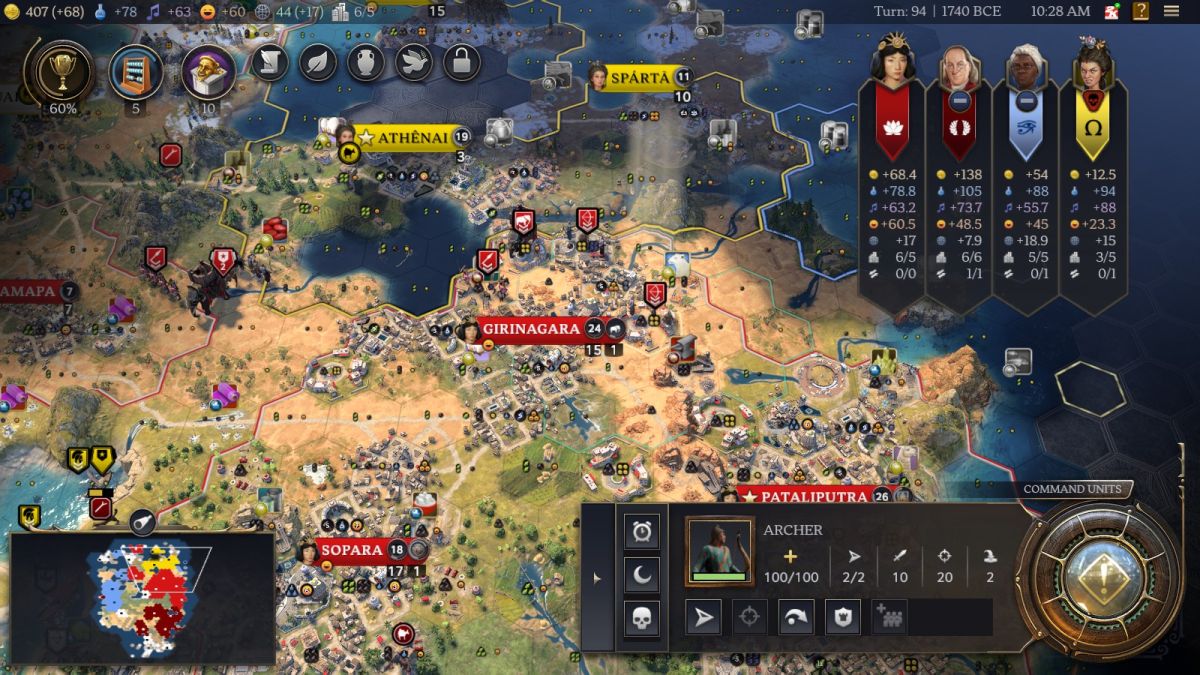
Diplomatic relations were terrible with Cathy and it was clear that she needed to go. I planned to focus on expanding overseas in the next era and I couldn't devote full resources to that with Catherine sitting there as a thorn in my heel. She had been doing some wonder building (including constructing the Hanging Gardens, one of the best Ancient era wonders) as well as moving a bunch of units off to the southwest. Some of those units are just visible in this screenshot and I waited for a few turns to see what they were doing over there without coming to any conclusion. There didn't appear to be much of anything back in the Greek homeland and this seemed like the perfect time to launch my own invasion. Mauryan archers and elephants crossed the border on Turn 94 and found no opposition whatsoever outside Cathy's capital, with three archers popping out of the army commander to fire on Athenai immediately. They launched another volley of arrows on the next turn and Catherine's capital fell without any further ado:
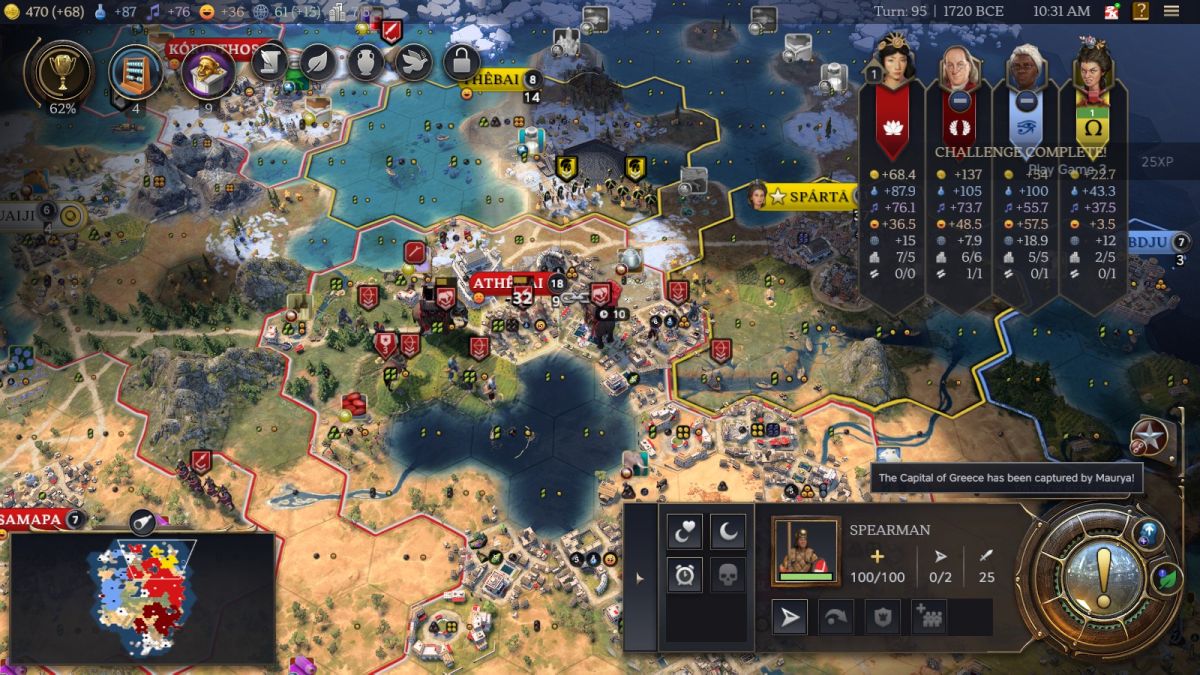
I was honestly shocked at how easy this was to pull off, Cathy simply didn't have anything at all back on defense. Speed appears to be a major factor when invading the AI in this game, since they will start spamming out units quickly once attacked but appear to be highly vulnerable to fast-moving alpha strikes. At this point Catherine began mustering some hoplite defenders but it was already too little, too late for her. Her units in the southwest were intercepted by some of my reinforcing units before they could cause any serious trouble while the new Greek units were too isolated to put up a real fight. Cathy was limited here by having only a single city remaining over at Sparta; Thebai was only a town and therefore couldn't train new units itself. The fighting was routine from here, with Sparta taking several turns for the archers to chip down the city fortifications (should have brought at least one ballista) followed by a bit of a traffic jam as my army converged on Thebai. All of the tundra terrain in the north was wooded and ended the turn of my units moving up there which slowed progress a bit. Still, the outcome of the fighting was never in doubt and Thebai fell on Turn 107 to bring an end to the war and eliminate Cathy:
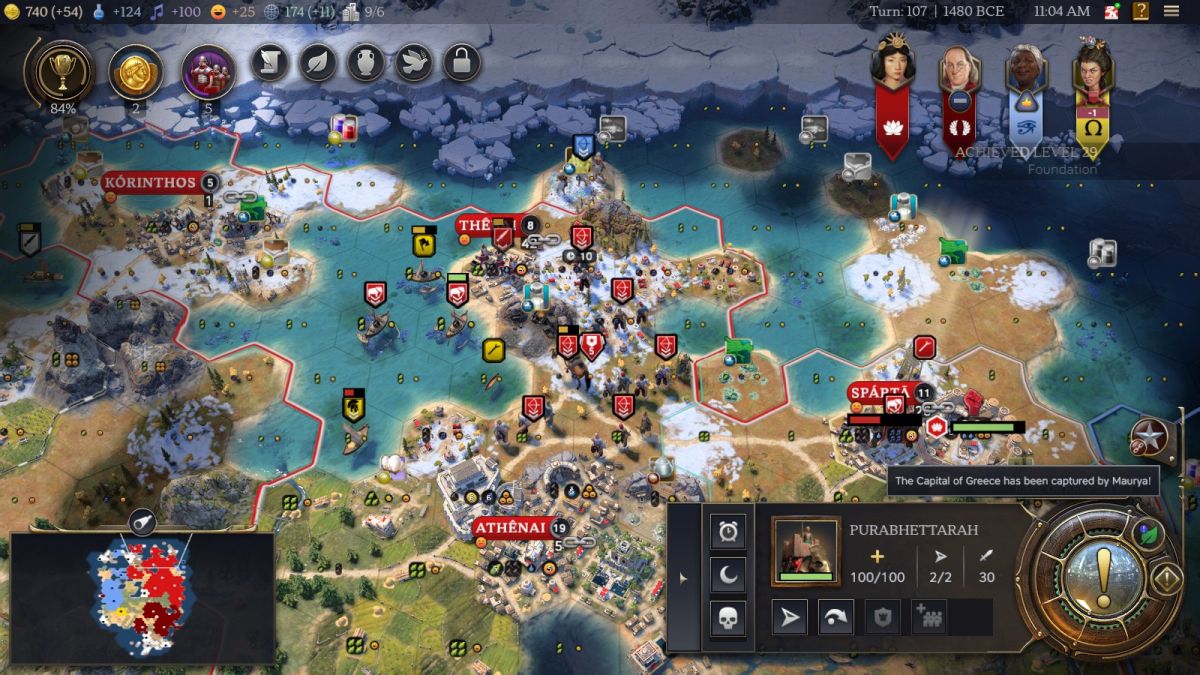
Wait a minute, why wasn't she dead yet? It wasn't the settler sailing around in the icy waters, merely having a settler is not sufficient for a civ to remain alive in this game. I scanned the map for a little bit and then found the culprit:
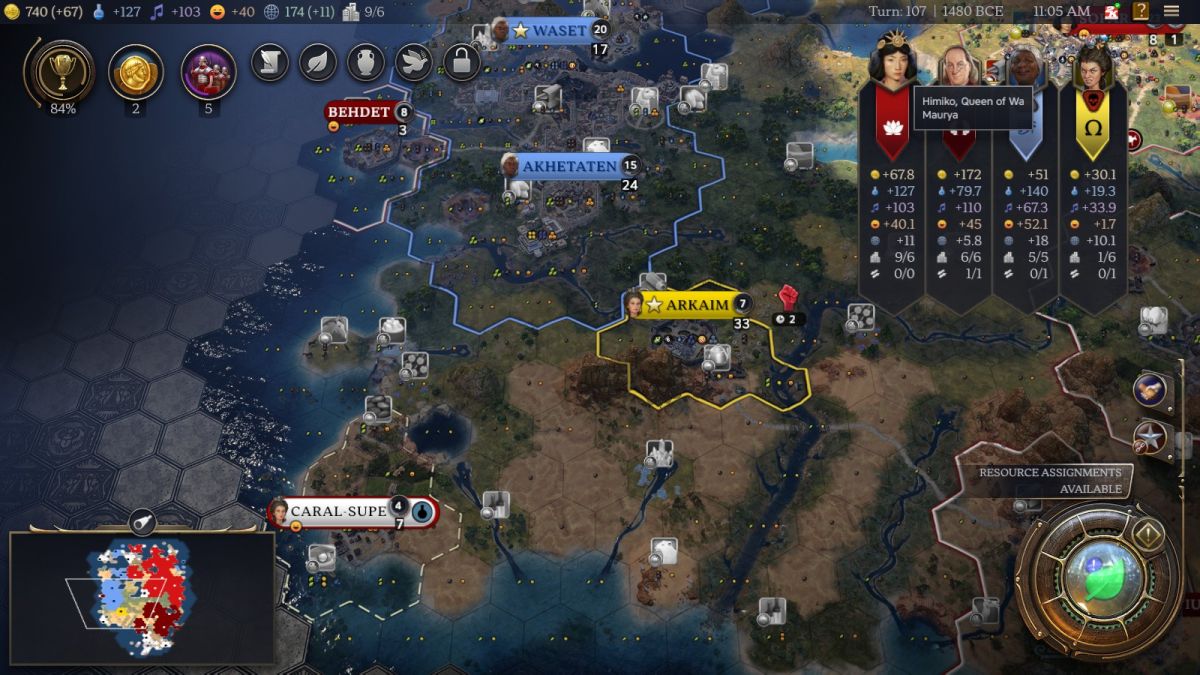
Oh for crying out loud, there was another Cathy city down there!  She was at war with Harriet Tubman and somehow, inexplicably, had captured this city from the Egyptians a few turns earlier. This is another maddening aspect of Civ7 as the AI leaders are absolutely obsessed with establishing settlements in bizarre parts of the map unconnected to the rest of their territory. Leaving aside this city that Cathy had captured in the far southwest, Franklin also had the captured Behdet west of Tubman's territory while Tubman herself founded a settlement on an offshore island east of Sparta. Meanwhile, vast stretches of the southern part of this continent contined to be completely unclaimed in favor of these illogical spots. I have no idea why the AI leaders keep doing this since it makes no sense and looks terrible on the minimap.
She was at war with Harriet Tubman and somehow, inexplicably, had captured this city from the Egyptians a few turns earlier. This is another maddening aspect of Civ7 as the AI leaders are absolutely obsessed with establishing settlements in bizarre parts of the map unconnected to the rest of their territory. Leaving aside this city that Cathy had captured in the far southwest, Franklin also had the captured Behdet west of Tubman's territory while Tubman herself founded a settlement on an offshore island east of Sparta. Meanwhile, vast stretches of the southern part of this continent contined to be completely unclaimed in favor of these illogical spots. I have no idea why the AI leaders keep doing this since it makes no sense and looks terrible on the minimap.
Anyway, it was clear that I wasn't going to be able to capture this final hiding spot so I signed peace with Catherine and resigned myself to being content with having picked up three new settlements. Athenai and Sparta both looked like they would make for good cities down the road and I hoped to upgrade them from town status before the era concluded. The two former Greek settlements in the extreme northern tundra could remain as towns due to the low quality of their local terrain, and maybe they would even provide some useful food under the new growth mechanics. Absorbing Cathy's cities had further swelled my science and cultural output, while happiness remained in surprisingly good shape despite being three settlements over the cap. That was the Mauryan civ at work there; I hoped to have enough time to get their unique quarter completed in a few more places before hitting the era transition.
I thought that I would have some more time here to continue pursuing the scoring objectives for the Ancient era. As it turned out, I was wrong:
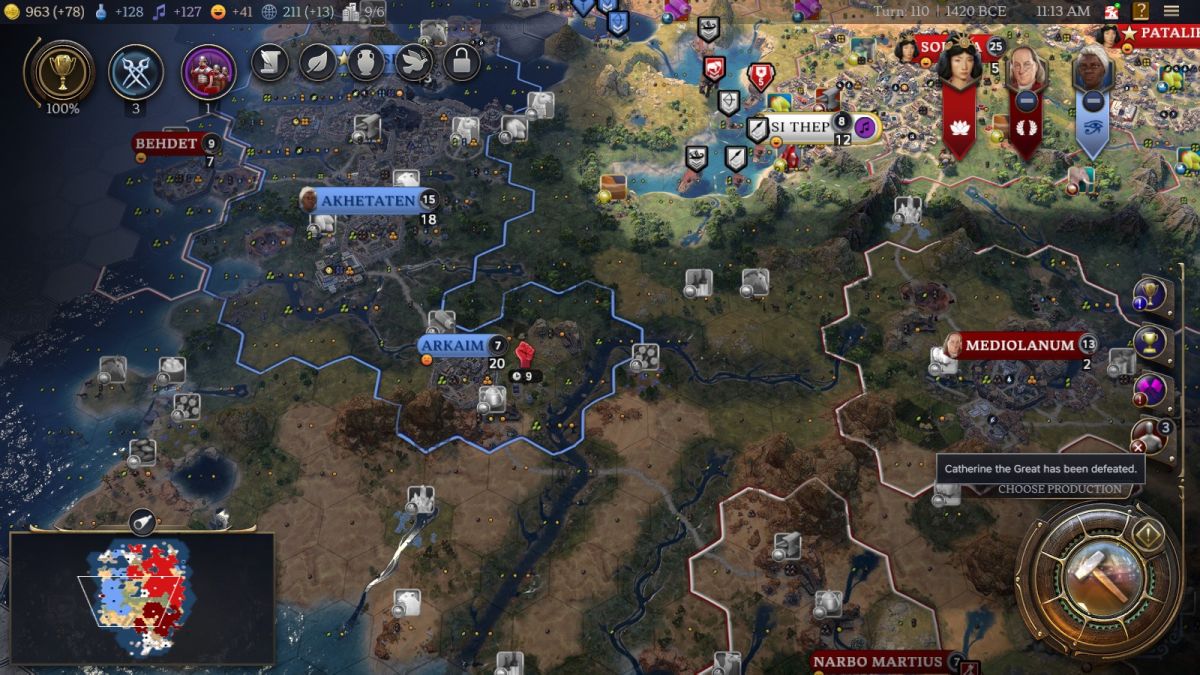
Tubman captured Arkaim back a mere three turns later to eliminate Catherine! There's a huge era score increase associated with eliminating a civ (something else that goes completely unexplained and undocumented in Civ7) and this, combined with Tubman hitting 10 codices on the same turn, jumped the era score by 15% in a single turn to reach the 100% finishing line. I was shocked at the era ending so quickly - wait, how could Turn 110 be the final turn of the era this quickly? If you look back at some of the earlier screenshots, the meter was sitting at 62% on Turn 95 and then 68% on Turn 101. It took 100 turns for the first two-thirds of the era and then NINE TURNS for the final third?! The age was also reading 78% on Turn 105 and 85% on Turn 109 before filling up entirely on the current Turn 110. I understand logically what was happening, with the hidden era scoring increasing rapidly as various leaders achieved the legacy scoring goals over these final turns, but this is a horrible mechanic in terms of player experience. There's no explanation of what's going on, no warning of when the era is going to end, and the era transitions themselves are absurdly jarring. One turn the player is in the middle of fighting a war or building their cities, then suddenly the era meter increases by 15% in a flash and they're being told that the era is over. There's no option to play on further, everything shuts down and your civ gets killed off to be replaced by an entirely new civ in a different era with different units, buildings, techs, civics, etc.
Did the developers think that players would enjoy this?!? 
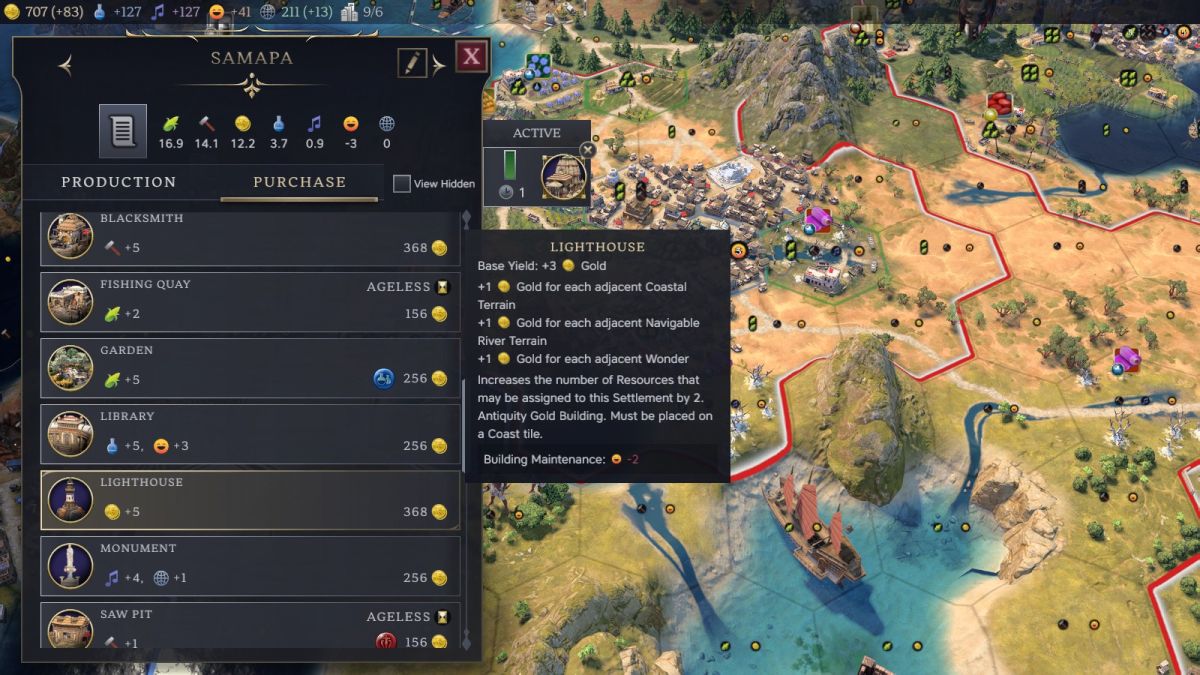
Worst of all, I was caught so unprepared that I still hadn't finished several of the legacy scoring goals. Taking those cities from Catherine had finished off the Military goal with ease so that wasn't an issue. I was never going to get the Cultural legacy and things simply ended too fast to get more than a handful of codices; I thought that I could finish the Science path only to run out of time. The category that I really cared about was the Economic legacy because I did not want my cities to collapse back into towns again. I had plenty of resources available, 23 slottable resources plus another 10 global resources, my issue was lacking enough resource slots to hit the requirement of 20 for this condition. I completely lacked any camel resources in my territory and then didn't have any cities along the coast, missing out on some of the buildings that add more resource slots. Fortunately I had 900 gold saved up and I was able to purchase my way over to a water tile at Samapa, then buy a lighthouse which added two more resource slots to get me up to 20/20 resources assigned for the Economic Golden Age. At least now I wouldn't lose out on the progress I had made by accumulating 4 cities to go with my 5 towns.
This is an aspect of the Civ7 gameplay that I absolutely detest: it constantly feels like you're on the clock. Have to get all those resources or your cities fall back into towns in the next era. Have to build everything with the "ageless" tag possible before you lose the chance in the next era. I keep feeling as though I have to hit certain milestones before the era transition arrives or I'll be massively penalized when the next age begins; this is not a type of game designed to operate under time pressure and it kills the enjoyment factor in a huge way. I suspect this is a big reason why so many players have reacted negatively to Civ7 even if they can't always articulate why they feel this way.
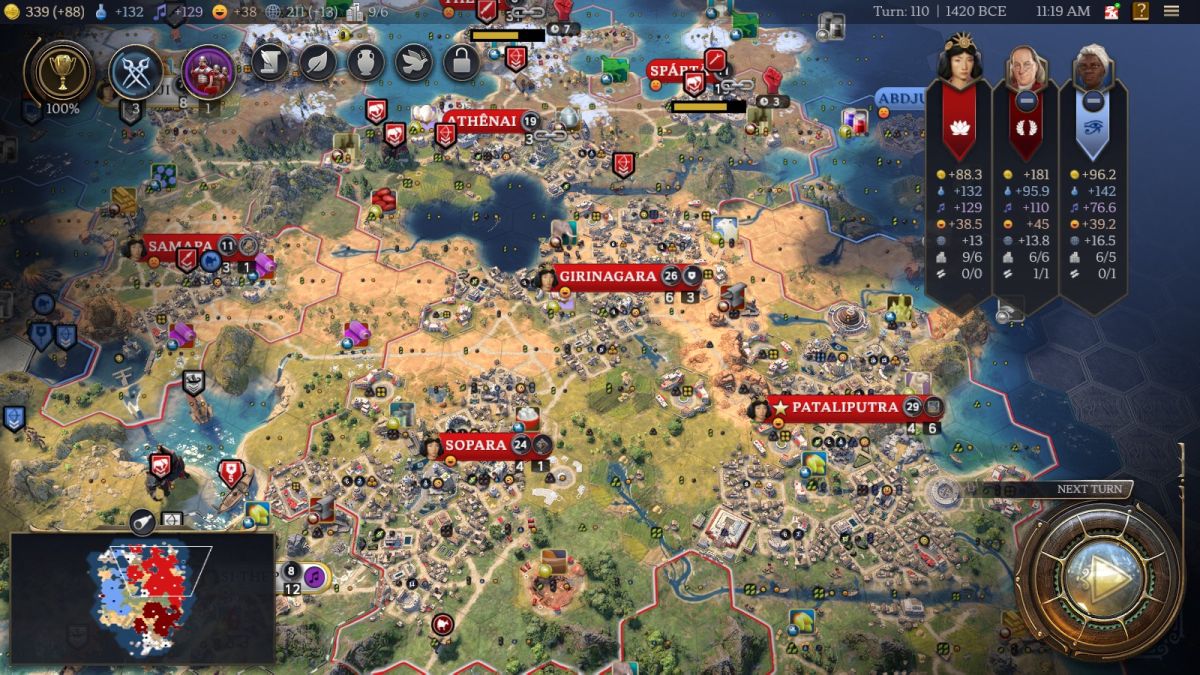
Here's an overview at the end of Turn 110 once I had finished up the final tinkering of my cities. It had been a very good Ancient era despite my frustrations at how the age concluded, with half again the territory of any other leader and my biggest rival eliminated. I was essentially already the top civ in the game and the patch that supposedly made the difficulty level much harder didn't feel particularly threatening thus far. If this was Deity difficulty, it was nothing like the same designation in Civ3 or Civ4.
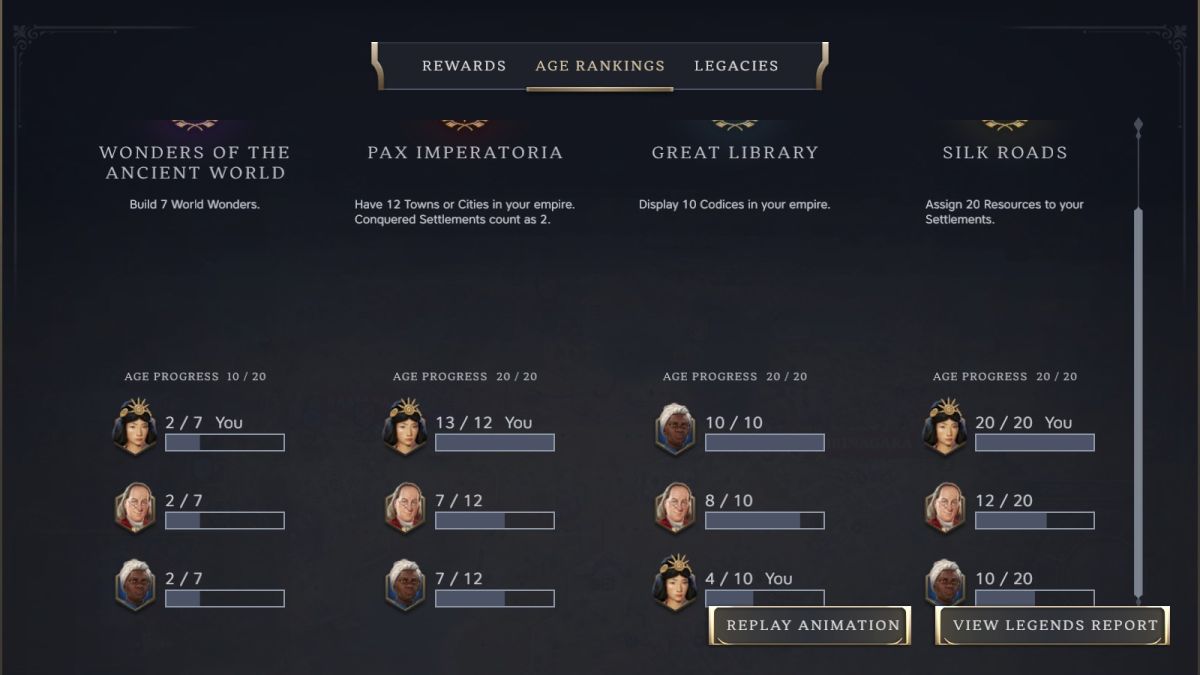
And this was the final legacy scoring for the Ancient era. I have to give the AI credit here: they were legitimately competitive at all four of these scoring goals. They love to build the world wonders, they expand reasonably well and don't hesitate to go to war, they will assign resources to their cities, and here on Deity they get enough boosted science that they claim the codices at a rapid pace. This is a major reason why everyone online talks about how the Ancient era is the best part of Civ7: the AI leaders know how to play the game here and they can compete for the scoring targets. And that's absolutely critical: in order for Civ7's gameplay to work, the AI *HAS* to be able to chase after the scoring goals. Unfortunately, as we all know by now, the AI is completely unable to obtain many of the later era scoring objectives, and the gameplay of these eras unravels as a result. This would be improved by choosing different scoring goals for those eras, or better yet, removing the whole concept of legacy scoring altogether which has had almost entirely negative effects on the gameplay. It's very clear that Civ7 would be a far superior game if the Ancient era simply continued indefinitely without having any era breaks. I suspect the single most popular thing that the developers could do would be to introduce an "ageless" game mode of exactly that sort.
No such option existed for now though, so thus into the Exploration age went Himiko. What new adventures lay in store for her in the distant lands overseas?



